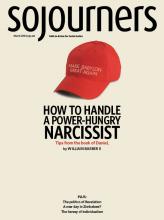IN A HISTORIC STATEMENT last November, Pope Francis categorically condemned not only “the threat” of nuclear weapons but also “their very possession.” In December, the Norwegian Nobel Committee awarded the Peace Prize to the International Campaign to Abolish Nuclear Weapons for its work on a new global treaty to prohibit nuclear arms. Already approved by the United Nations, it’s expected to enter into force this year. The Vatican was one of the first to ratify.
Here in the United States, however, it’s like we live in the Twilight Zone. President Donald Trump threatens to “totally destroy North Korea,” tweets about how his “nuclear button” is bigger than Kim Jong Un’s, and is moving ahead with plans to spend $1.7 trillion to rebuild the nuclear arsenal over the next three decades.
Trump’s bombastic rhetoric and impulsive tweets worry Democrats and Republicans alike, with Sen. Bob Corker (R-Tenn.) saying in October, “We could be heading toward World War III with the kinds of comments that he’s making.” In a sign of growing concern, the GOP-controlled Senate held the first congressional hearing on the president’s authority to launch nuclear weapons in 41 years. Sen. Chris Murphy (D-Conn.) said Americans are concerned that President Trump “is so unstable, is so volatile” that he might order a nuclear strike that is “wildly out of step” with our national security interests.
Yet there is a relatively simple step the United States could take that would 1) limit President Trump’s nuclear options, 2) reduce the risk of war, 3) respond to growing international calls to eliminate atomic arms, and 4) save a boatload of money.
It is time to retire our Intercontinental Ballistic Missiles (ICBMs).
Read the Full Article

